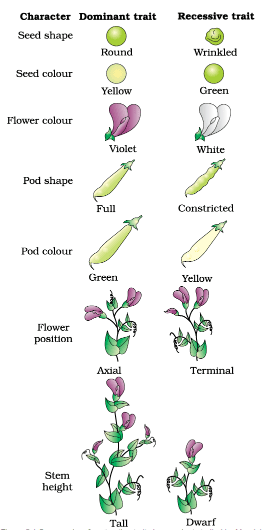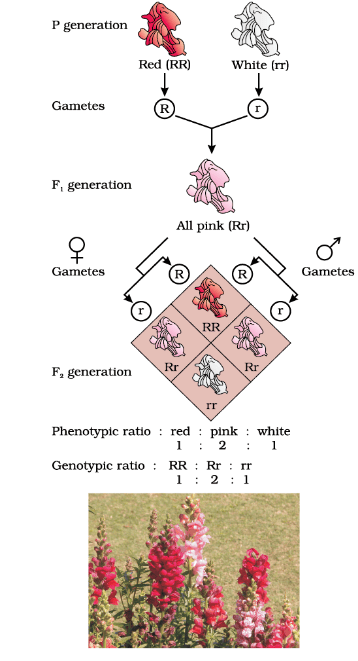Principles of Inheritance & Mendal laws of Inheritance | Biology Class 12 - NEET PDF Download
| Table of contents |

|
| Mendel’s Laws of Inheritance |

|
| Inheritance of One Gene |

|
| Principles or Laws of Inheritance |

|
| Incomplete Dominance |

|
| Co-Dominance |

|
Mendel’s Laws of Inheritance
Mendel's work laid the foundation for our understanding of how traits are passed down from one generation to the next. He focused on simple traits in pea plants, like height and seed color, and used careful experiments to uncover the basic rules of inheritance.

Introduction
- In the mid-19th century, significant progress was made in understanding how traits are passed from parents to offspring.
- Gregor Mendel, through his hybridization experiments on garden peas over seven years (1856-1863), proposed fundamental laws of inheritance in living organisms.
- Mendel was the first to apply statistical analysis and mathematical logic to biological problems during his investigations into inheritance patterns.
- His experiments involved a large sample size, lending greater credibility to his findings.
- The confirmation of his results through experiments on successive generations of pea plants demonstrated that his conclusions reflected general rules of inheritance rather than mere conjectures.
True-Breeding Lines
- A true-breeding line is a group of organisms that, over many generations of self-pollination, consistently produce offspring with the same stable traits.
- Mendel selected 14 pairs of true-breeding pea plant varieties that were similar except for one contrasting trait. For instance, he might choose one variety with smooth seeds and another with wrinkled seeds.
Contrasting Traits
Some of the contrasting traits Mendel studied included:

Inheritance of One Gene
- Trait: A feature or characteristic of an organism, like eye color or height.
- Gene: A unit of heredity, a segment of DNA that determines a specific trait.
- Allele: A variant form of a gene, such as the gene for flower color having a blue or white allele.
- Homozygous: Having two identical alleles for a trait, like two blue alleles for flower color.
- Heterozygous: Having two different alleles for a trait, like one blue and one white allele for flower color.
- Phenotype: The observable physical or physiological traits of an organism, like the color of its flowers.
- Genotype: The genetic makeup of an organism, represented by the alleles it carries, like BB or Bb for flower color.
- Dominant Trait: A trait that appears in the phenotype even when only one allele is present, like blue flowers in a plant with one blue and one white allele.
- Recessive Trait: A trait that only appears in the phenotype when both alleles are recessive, like white flowers in a plant with two white alleles.
Introduction to Mendel's Experiment
- Mendel conducted a hybridization experiment by crossing tall and dwarf pea plants to study the inheritance of one gene.
- The seeds produced from this cross were collected and grown to generate the first hybrid generation, known as the Filial 1 progeny (F1).

Observation of F1 Progeny
- Mendel observed that all the F1 progeny plants were tall, resembling one of the parents, and none were dwarf.
- This pattern was consistent across other pairs of traits, where the F1 generation always resembled one parent and did not show the trait of the other parent.
Self-Pollination of F1 Plants
- When Mendel self-pollinated the tall F1 plants, he found that in the Filial 2 generation (F2), some offspring were dwarf, a trait that was not seen in the F1 generation.
- The F2 generation exhibited a ratio of 3:1, with 3/4th being tall and 1/4th being dwarf.
Introduction of Concepts
- Mendel proposed that factors(now known as genes) were being passed down unchanged from parent to offspring through gametes.
- Genes are units of inheritance that contain information necessary for expressing specific traits.
Alleles and Genotypes
- Genes coding for contrasting traits are called alleles.
- For example,T represents the tall trait and t represents the dwarf trait.
- Plants can have pairs of alleles like TT(homozygous tall),Tt(heterozygous tall), or tt(homozygous dwarf).
Dominance and Recessiveness
- Mendel found that in a pair of dissimilar factors, one factor dominates the other, as seen in the F1 generation.
- In the case of height,T(tall) is dominant over t(dwarf).
Monohybrid Cross
- The cross between TT and tt plants is called a monohybrid cross.
- Mendel's observations led to the principle of segregation, where alleles segregate randomly into gametes during meiosis.

Punnett Square
- The Punnett Square is a tool developed by Reginald C. Punnett to predict the probability of different genotypes in offspring.
- It helps visualize the gametes produced by parents and the possible combinations in the offspring.

F2 Generation and Ratios
- In the F2 generation, a phenotypic ratio of 3:1 (tall to dwarf) and a genotypic ratio of 1:2:1 (TT:Tt:tt) are observed.
- The 1/4:1/2:1/4 ratio of TT:Tt:tt can be represented using the binomial expression (1/2T + 1/2t) 2.
Test Cross
- To determine the genotype of a tall F2 plant, Mendel performed a test cross by crossing the tall plant with a dwarf plant.
- A typical test cross involves crossing an organism with a dominant phenotype (whose genotype is unknown) with a recessive parent to analyze the offspring.

Conclusion
Mendel's experiments and observations laid the foundation for the understanding of genetic inheritance and the principles of dominance, segregation, and the role of alleles in determining traits.
Principles or Laws of Inheritance
Based on his observations from monohybrid crosses, Mendel formulated two fundamental rules to articulate his understanding of inheritance. These rules are now recognized as the Principles or Laws of Inheritance: the First Law (Law of Dominance) and the Second Law (Law of Segregation).
Law of Dominance
- According to this law:
- Characters are governed by distinct units known as factors.
- Factors exist in pairs.
- When a pair of factors is dissimilar, one factor dominates over the other. The dominant factor is expressed, while the recessive factor is masked.
The Law of Dominance explains the following:
- In the F1 generation of a monohybrid cross, only one parental character is expressed due to dominance.
- In the F2 generation, both parental characters appear, reflecting the segregation of alleles.
- The 3:1 phenotypic ratio observed in the F2 generation.
Law of Segregation
- This law is based on the principle that alleles do not blend and are recovered intact in the F2 generation, even though one allele is not visible in the F1 generation.
- During gamete formation, the alleles of a pair segregate from each other, so each gamete receives only one of the two alleles.
- A homozygous parent produces identical gametes, while a heterozygous parent produces two types of gametes, each with one allele, in equal proportions.
Incomplete Dominance
When scientists conducted experiments on different traits in various plants, they discovered a phenomenon called incomplete dominance. This occurs when the F1 generation exhibits a phenotype that is a blend of the two parental traits, rather than resembling either parent exactly. A classic example of incomplete dominance is seen in the inheritance of flower color in the dog flower, also known as snapdragon (Antirrhinum sp.).

Example of Incomplete Dominance in Snapdragons
- In a cross between true-breeding red-flowered plants (RR) and true-breeding white-flowered plants (rr), the F1 generation (Rr) displayed a pink phenotype.
- When the F1 plants were self-pollinated, the F2 generation exhibited a phenotypic ratio of 1 Red (RR): 2 Pink (Rr): 1 White (rr).
- Although the genotype ratios followed the expected Mendelian monohybrid cross pattern, the phenotypic ratios differed from the typical 3:1 dominant to recessive ratio.
- This shift occurred because the red allele (R) was not completely dominant over the white allele (r), allowing the heterozygous (Rr) phenotype to be distinctively pink.
Key Points About Dominance:
- Dominance refers to the relationship between alleles and how they influence the expression of traits.
- Not all alleles are created equal; some are dominant while others are recessive based on the traits they produce.
- A gene carries the information necessary to express a specific trait, and in diploid organisms, there are two copies of each gene (alleles).
- Alleles can differ due to changes, leading to variations in the information they provide.
- For example, in a gene responsible for producing an enzyme, one allele might produce a normal enzyme while the other could produce a less effective or non-functional enzyme.
In cases where the modified allele produces a non-functional enzyme or no enzyme at all, the phenotype will depend on the functioning of the unmodified allele. The unmodified allele, which represents the original phenotype, is considered the dominant allele, while the modified allele is typically the recessive one. Therefore, the recessive trait may manifest due to a non-functional enzyme or the absence of enzyme production. This illustrates the concept of dominance and how certain alleles can override others in determining phenotypic traits.
Co-Dominance
Co-dominance is a genetic phenomenon where the offspring (F1 generation) exhibit traits from both parents equally, rather than resembling just one parent (dominance) or showing a blend of traits (incomplete dominance).
Example: ABO Blood Groups in Humans
- ABO blood groups are determined by the gene I, which has three alleles: IA, IB, and i.
- The IAand IBalleles produce different sugar types on the surface of red blood cells, while the i allele does not produce any sugar.
- In humans, who are diploid, each individual has two of these three alleles.
- Dominance Hierarchy:
- IAand IBare co-dominant to each other and dominant over i.
- When IAand i are present, only IAis expressed.
- When IBand i are present, only IBis expressed.
- Co-Dominance:
- When both IAand IBare present, both sugars are produced, resulting in AB blood type.
Because there are three alleles, there are six possible combinations, leading to six different genotypes and four phenotypes:

Multiple Alleles
The ABO blood group system also illustrates multiple alleles, as more than two alleles (IA, IB, and i) control the same trait.
Example of One Gene with Multiple Effects:
 Starch synthesis in pea seeds is controlled by one gene with two alleles (B and b)
Starch synthesis in pea seeds is controlled by one gene with two alleles (B and b)
This example shows that dominance can vary depending on the specific phenotype being observed.
|
78 videos|276 docs|174 tests
|
FAQs on Principles of Inheritance & Mendal laws of Inheritance - Biology Class 12 - NEET
| 1. What are Mendel's Laws of Inheritance? |  |
| 2. What is the difference between incomplete dominance and co-dominance? |  |
| 3. How does the Principle of Segregation apply in genetic crosses? |  |
| 4. What are some examples of traits that exhibit co-dominance? |  |
| 5. How can Mendel's laws be applied to modern genetics? |  |

|
Explore Courses for NEET exam
|

|


















